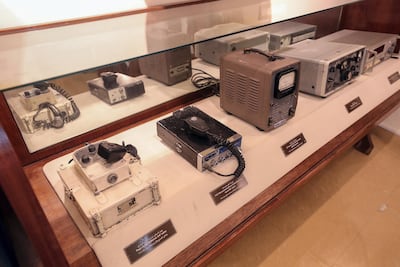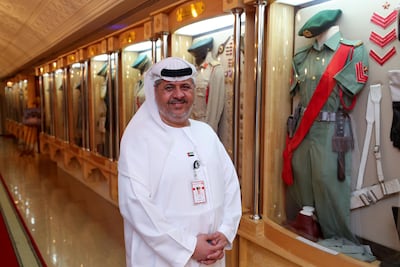If policing has become increasingly dominated by technology, drones and high-tech gadgets, then Dubai Police Museum offers a glimpse at how the cops kept the streets safe in simpler times. Hidden within the police headquarters in Al Twar, it is a surprising treat for history buffs and crime enthusiasts.
From the early telecommunication devices used to some of the unusual drug busts of the 1980s, the museum tells the story of Dubai Police from the early days to its place as the world-renowned force it is today. Established on November 19, 1987, the museum has spent 30 years charting the history and scientific investigative methods of the Dubai Police, themselves established in 1956. As well as documents, awareness brochures, department and unit briefs, old military uniforms, photographs and logos stretching back to the force’s early days, the establishment of a female unit is also covered here.
Lieutenant Mansoor Al Mansoori, head of the museum, told The National: "Dubai Police Museum has seven kinds of exhibits, including those about military and technical equipment, investigation and criminal evidence, as well as social participations."
Visitors are greeted by portraits of Dubai’s leaders and senior officials, top police officers, and a portrait of Sheikh Mohammed bin Rashed Al Maktoum, Vice President and Prime Minister of the UAE and Ruler of Dubai, from when he was the head of the Dubai Police Force and the Dubai Defence Force in 1968.
Further inside, sections include one showcasing memorabilia from the Dubai Police’s golden jubilee celebrations in 2006, which marked 50 years since its establishment. A fire ripped through the museum the same year, but fortunately most of the artefacts were saved.
Police officer uniforms, worn since 1975, for both the force and the academy, are also on display, as well as vintage equipment. "Dubai police used a Marconi digital frequency meter before 1980,” said Lieutenant Al Mansoori. “Radar flasher units were used before 1976 to ensure that motorists abided by the speed limit."

Women in the Dubai Police
One of the highlights of the museum is the history of its female police force. The first Emirati female police officer in both Dubai and the UAE was Tofaha Al Hamed, appointed in 1960s. Yet it was in 1977 that the female force was established, and the first wave of women included eighteen students who were trained at a police training school in Jumeirah for four months.
Major drug busts
Highlighting the weirdest methods used by drug smugglers in attempts to bring their goods into the country, this section shows how traffickers developed a variety of inventive ways to obscure their shipments of drugs. Inspectors have discovered drugs hidden in shipments of oranges, walnuts, almonds and slippers. Police also foiled a bid at Dubai airport in 1987 to smuggle in heroin hidden in a photo album in a Samsonite bag. The fingerprints of the culprits are on display.
Traffic awareness campaigns
Traffic awareness campaigns were introduced in the 1980s. The posters, pamphlets and brochures distributed to motorists as part of the second traffic awareness campaign organised by Dubai Police are showcased at the museum. “Dear reader,” one poster reads. “A large number of people are injured or become disabled as a result of the rise in car accidents. Therefore, Dubai Police’s public relations visited one of the victims of a traffic accident in 1984. The victim told police officers that the cause of the accident was driving at a speed of 220km/h and said that he regrets driving recklessly.” The victim of crash was 19 years old, it says.

Punitive and correctional establishments
A brief about the history of punitive establishments is posted on the wall of a section at the museum. The first punitive and correctional establishment was in Dubai’s oldest existing building, Al Fahidi castle, and in the mid-1950s Naif Fort was used. In 1973, the Dubai Central Jail was established in Al Aweer in line with Dubai Police’s strategy to focus on reforming prisoners rather than punishing them. The punitive and correctional establishments have now been revamped to include recreational facilities and workshops for prisoners to learn crafts.
Forensic laboratory
A forensic laboratory was established in 1981 as an affiliate of the Dubai Police criminal investigation department, and later became part of the general department of forensic science and criminology. The museum showcases its work in criminal chemistry, forensic toxins, fire-fighting, weapons and equipment, and biological and genetic fingerprinting.
The Dubai police museum is free and open to the general public following co-ordination with the director of the museum, or though the Dubai Police phone app on Android and Apple.
For more information visit the Dubai Police website, or call +971 4 269 2222.













